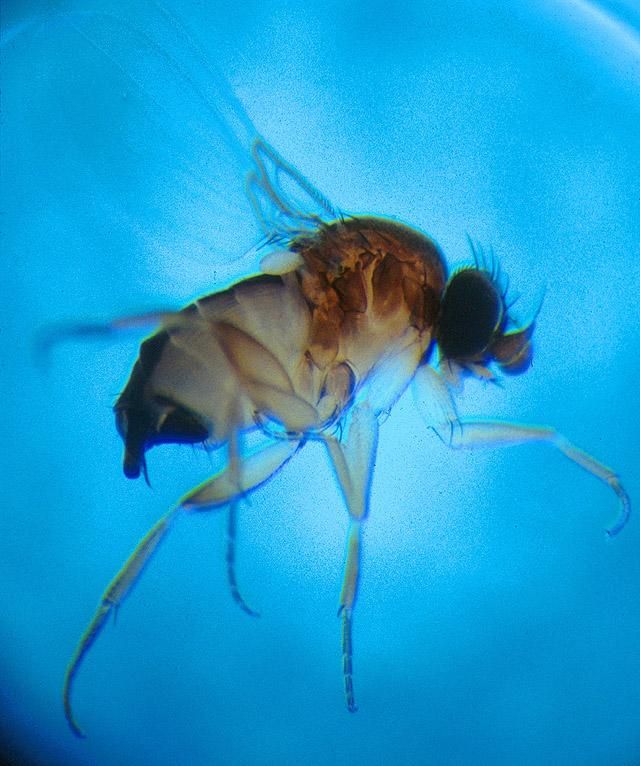SERVICE REQUEST?
Fill out the form below.
Find our nearest location
Your Local Office

Phorid Fly
Attribution: Sanford Porter, U.S. Department of Agriculture, via Wikimedia Commons
Size:
Small flies 1/8-inch in length
Color:
Tan brown with black eyes; small head; a severely arched (humpbacked) thorax when viewed from the side.
Behavior:
Also known as the humpbacked fly, phorid flies are common in homes and commercial facilities where food is prepared and served, but they are also a key pest in mausoleums, food warehouses, and hospitals. Because these flies frequent unsanitary conditions, they are a potential health concern when they occur in food facilities and hospitals.
Phorid flies are capable in breeding in more types of materials than any other structure-infesting flies. In nature, they are typically associated with dead animals and heavily decaying vegetation. In mausoleums, they are known as “coffin flies” because they breed inside bodies stored in the crypts and coffins. In buildings, they may found breeding in drains, trash containers, dumpsters, rotting produce, recycle bins, grease traps, garbage disposals, crawlspaces, and any site where moist organic matter can accumulate for five days or longer. Phorid flies have also been found to breed in poorly stored meats, damaged containers of moist foods, and organic-based glues and paints.
The key to controlling phorid flies is finding the breeding sites and removing them by proper cleaning practices. Phorid flies, like other types of small flies, can be difficult to totally eliminate because they can breed in such small amounts of organic matter. A number of breeding sites can be found and eliminated while others may easily be overlooked. The inspection needs to focus on finding all sites where moist organic matter has accumulated and then removing that matter completely.
On occasion, drain line breaks under slabs or in crawlspaces can result in huge phorid fly populations in homes, restaurants, or other buildings. Drain breaks beneath a slab floor will require the expertise of a plumber to diagnose. If flies are found to be breeding under the slab, the slab will need to be broken open and the drain line repaired. If the wet, contaminated soil is not removed and replaced with fresh, dry soil, the phorid fly problem will persist.
Family Name:
Family Phoridae
Read What Our Clients
Are Saying
My Terminix tech Scott is the best! He is professional, courteous and absolutely thorough about his job. Thank you for sending such a blessed tech to my house. Hamlet, NC
This letter is to say how pleased we are here at Morreene West Apartments with your services. We are very pleased with the technician, Christopher. He does a great job. Durham, NC
Terminix has consistently offered our apartment complex reliable, competent service. We are completely satisfied with their knowledgeable representative who is always punctual and does a superior job for us every time. Chapel Hill, NC
I would like to take the time to thank you for giving us such great service here at Carver Pond Apartments. Your Pest Technician Christopher Mitchell has provided us with excellent service over the last few months. Christopher is such a great help to us in providing helpful information so that we can better serve our residents here at Carver Pond. Durham, NC
SERVICE REQUEST?
Fill out the form below.